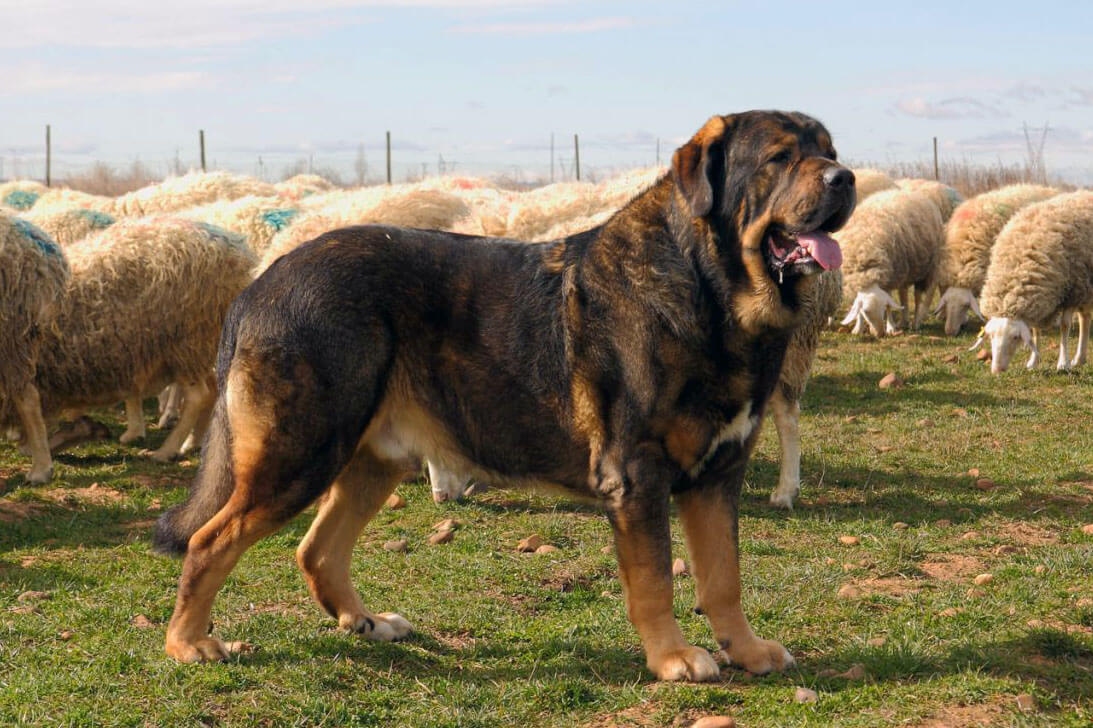The Spanish Mastiff is a well-muscled and impressive dog. It was largely used as a military dog for its agile and watchful nature and as a livestock guard. Read on to find more about this famous breed.
Spanish Mastiff Appearance
Table of Contents
Spanish Mastiff is a giant breed. It was bred as a livestock guardian dog to keep flocks away from wolves and all sorts of predators. It is quite similar to other dogs of this breed. It has a large head and its expressions are quite vigilant and serious.
Spanish Mastiff has a long muzzle with a powerful jaw and well-developed lips. It has small eyes with watchful expressions and the triangular ears drop to the sides. This breed has a bushy long tail. The male stands 28 to 33 inches in height and weighs 50 to 70 kg. The female is smaller and measures around 26 inches in height and weighs 40 to 60 kg.
The coat of the Spanish Mastiff varies from fawn-colored and brindle to wolf and black-colored. Because of its large size, this breed makes excellent watchdogs.
Spanish Mastiff Grooming
The Spanish Mastiff does not require a lot of brushing. Brushing the coat once a week gets rid of all the dead and loose hair. Occasional baths keep the dog clean and healthy. When brushing the dog, make sure to brush gently through the hair, as additional pressure may cause damage to the skin. Get a soft bristled brush and avoid any harsh combs.
Bathe your dog regularly for its overall health. Use a vet-approved shampoo that is especially meant for the dogs. Avoid using regular shampoos as they tend to cause dryness by stripping the natural oil. Check your dog’s ears regularly for any signs of infection or wax build-up. The ears of the dog must be cleaned using a vet-approved cleanser. Never use cotton swabs to clean the dog’s ear as it may cause severe damage.
The oral hygiene of your dog is as important as the overall health. Make sure you brush the dog’s teeth regularly to remove tartar and plaque effectively. There is a special toothpaste formulated just for the dogs that will can the job well.
Trim the dog’s nails naturally if they are unable to wear down naturally. You can use a nail grinder or clipper to avoid splitting, cracking, and overgrowth.
Spanish Mastiff Temperament
The Spanish Mastiff is a dignified and intelligent breed. It is highly loving of its owner and is always protective. It remains aloof and wary of strangers at first encounter due to its protective instincts but when socialized well, the breed is quite accepting.
This breed tends to be aggressive toward other dogs. Hence, it is important to watch its behavior and not to leave it for long hours alone or with other dogs. It enjoys open spaces and remains most happy in extensive yards and stately homes as compared to apartments.
It is important to begin their socialization from an early age to inculcate good habits and shun all the negative traits. Early socialization will also minimize aggressive behavior toward other dogs. In order to keep the dog motivated during training, you can introduce various treats and keep challenging to constantly stimulate its mind and body.
This breed needs consistent, gentle handling. An experienced trainer is required to train the dog. The dog will, however, need to establish trust before it obeys you. Once you win its trust, it will prove to be extremely loyal.
Spanish Mastiff Training
Training the Spanish Mastiff should begin from an early age. It is critical that the dog socializes from an early age so that it adjusts well with other dogs in later years. Always use positive reinforcement and introduce treats to keep the dog eager and motivated.
Do not use harsh words or any sort of punishment. Negative reinforcement may cause the dog to misbehave or show aggressive behavior. This breed requires a daily walk. Therefore, it is recommended that as soon as the basic training is over, you introduce advanced training or agility activities to challenge the dog. This breed learns at its own pace.
Spanish Mastiff History
This breed is quite old. It was first seen on the Iberian Peninsula were it was brought by the Phoenicians and Greeks before Roman invasion. Virgil first mentioned this breed in his poem ‘The Georgics’ stating that the protective and nurturing nature of the Mastiff will make it the best guardian dog.
The role of this dog grew significantly in the 10th century as guiding farm dogs. Its popularity soared in the 12th century with the development of the new genre of sheep. These dogs spent winters in Spain and moved to the mountains in the north during summers as guardians of the livestock. These dogs were well known for their weather-resistant coat along with their independent and defensive nature.
Other names
Mastín Español, Mastín Leonés, Mastín ganadero







